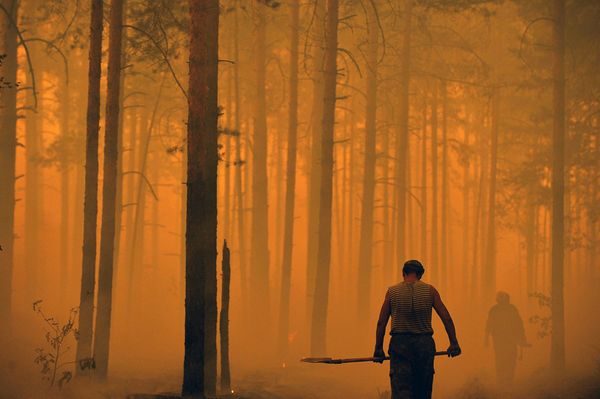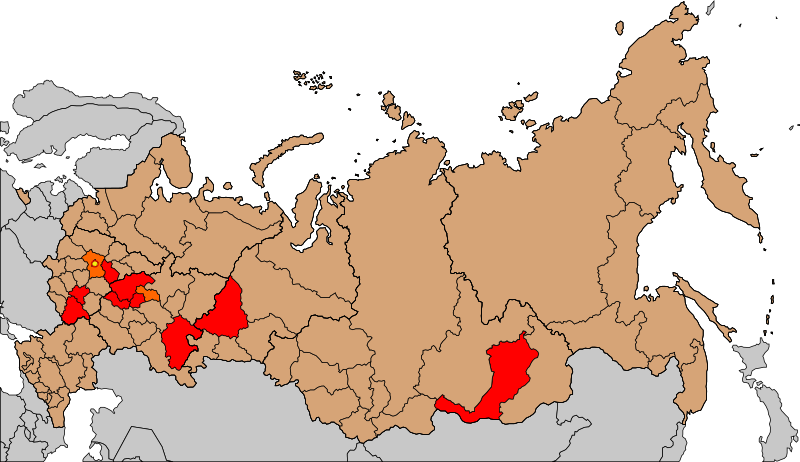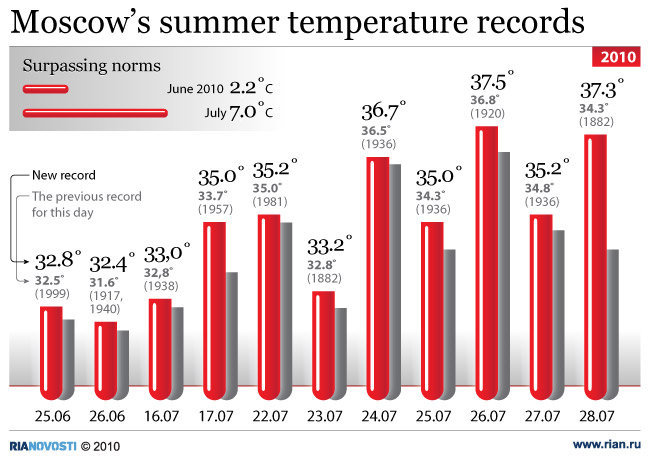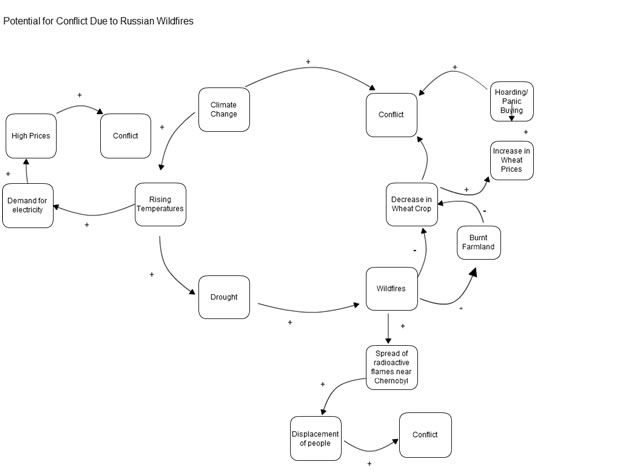![]()
I. CASE BACKGROUND
1. Abstract
 For years it has been said and joked that Russia could benefit from climate change…open shipping routes, longer growing seasons, and the availability of space and water for increased agricultural production. These ideas have permeated the Russian public, and Putin has even questioned if it was necessary to further reduce greenhouse gas emissions. However, this past summer Russia received a wake up call. Lasting over a 2-month period, hundreds of wildfires ripped across 7 regions due to extreme heat, while 28 others where left in a state of emergency as a result of failing crops from intensified drought.
For years it has been said and joked that Russia could benefit from climate change…open shipping routes, longer growing seasons, and the availability of space and water for increased agricultural production. These ideas have permeated the Russian public, and Putin has even questioned if it was necessary to further reduce greenhouse gas emissions. However, this past summer Russia received a wake up call. Lasting over a 2-month period, hundreds of wildfires ripped across 7 regions due to extreme heat, while 28 others where left in a state of emergency as a result of failing crops from intensified drought.
2. Description
The summer’s heat wave that brought Moscow’s temperatures to 130 year-high (in excess of 100 degrees), has illustrated the limitations of thinking that all can be well in a climate-changing world. The drought destroyed about 25 million acres of crops, and led to intense wildfires that resultantly conquered entire villages. Burning peat fields filled the air with pollution, and left a dark haze over Moscow and the surrounding areas. As a result of this, and other climate-related production declines, wheat prices rose about 90% . Image 1: Russian Fire
World Wheat Supplies and Economic Implications
World wheat supplies were sharply reduced as a direct effect of the droughts. The supply was 6.6% smaller that in previous projections and prices (1). The crop shortage exacerbated the economic and health turmoil that was already being felt during the heat wave. As fire and drought are now occuring more grequently, climate change experts are concerned that rising temperatures will threaten food security. Russian deputy economy minister, Andrei Klepach, remarked that the drought would take up to 0.8% off of the year’s economic growth (2). This figure equals about 313 billion roubles, or roughly $10.1 billion. However, the annual growth rate was not the only thing that was slowed. Weeks after the fires first broke out, consumer prices in Russia rose by 0.4% (2), the same increase that was seen during the whole month of July. According to Klepach, the August inflation rate was at about 0.5% at best (2).
The agricultural sector experienced a significant cascade effect, as dairy farmers had no choice but to start killing off their cattle, due to explosive fodder prices that they could not afford. The agricultural ministry estimated that the sector lost billions of roubles, as more than a quarter of the crops had been burnt. Due to fears of shortages, food prices also exploded, and despite a ban on exporting grain, basic products such as bread and milk became much more expensive then they were prior to the fires. It had also become increasingly difficult to buy buckwheat, a staple food ingredient among most Russians. This was the result of a poor harvest, as well as a higher demand due to consumers’ desire to stock non-perishable food (a result of panic-buying due to the fires).
Socio-Economic Implications
Image 2: Destroyed House From Fire  The rising amounts of droughts have also caused an increase in sickness and death rates due to growing amounts of dust. Pollutants such as aerosols, ozone, and bacteria were spread long distances, and led to a lack of clean water for drinking and sanitary purposes. The fires have also led to the destruction of houses, industrial plants, and electric power networks. As these problems continuously become exacerbated, people will take flight and migrate to eastward and northern expanses of Russia. Here, agricultural and development possibilities may arise due to melting permafrost, and ruined livelihoods could be supported.
The rising amounts of droughts have also caused an increase in sickness and death rates due to growing amounts of dust. Pollutants such as aerosols, ozone, and bacteria were spread long distances, and led to a lack of clean water for drinking and sanitary purposes. The fires have also led to the destruction of houses, industrial plants, and electric power networks. As these problems continuously become exacerbated, people will take flight and migrate to eastward and northern expanses of Russia. Here, agricultural and development possibilities may arise due to melting permafrost, and ruined livelihoods could be supported.
Future Implications
Though catastrophic, the results of the fire have the potential to encourage a policy shift from the top of the government. Putin, who has been known to joke about climate change as being good for Russia, admitted “this year we understood here in Russia that climate problems are really pressing for us as well.” (SOURCE) The results of climate change are clearly being felt, however it could be quite manageable for Russia in the coming decades. Adaptation must be a principle priority. Strategies that reduce the vulnerability to future climate change will have substantial co benefits for citizens of the region; stronger infrastructure and stronger institutional support for promoting adaptation will curb the effects of climate change in years to come.
3. Duration
Begin: July 2010
End: August 2010
Duration: Two month
Wildfire Timeline (source: Documenting Reality)
Day |
Event |
July 29th |
Peat fires start in Nizhny Novgorod Oblast, and other areas across Western and Central Asia |
July 31st |
It is reported that the fire situation in 17 federal subjects “is complicated” |
August 1st |
Area of the forest fires are 1,140 km2 |
August 2nd |
34 people dead |
August 4th |
Burning over 1,885.25 km2 |
August 5th |
843 reported outbreaks of fires, |
August 8th |
Smoke, arrives in Saint Petersburg |
August 10th |
Fires raged in radioactive polluted areas near Bryansk. The Bryansk region, is heavily polluted because of the Chernobyl disaster |
August 11th |
Sky is clear, fires are reduced to half of what they were |
August 12th |
Number of fires reduced from 612 to 562, the skies over Moscow were mostly clear |
4. Location
 The Russian wildfires were several hundred fires that broke out across Russia. However, they were primarily located in the West (surrounding Moscow),where record temperatures were causing the hottest summer in history.
The Russian wildfires were several hundred fires that broke out across Russia. However, they were primarily located in the West (surrounding Moscow),where record temperatures were causing the hottest summer in history.
Figure 3: Fire outbreaks on July, 31st
5. Actors
- The Russian People
- Russian Government
- NGOs
- Foreign Aid providers
![]()
II. Environment Aspects
 6. Type of Environmental Problem
6. Type of Environmental Problem
Climate Change: Warming Temperatures
7. Type of Habitat
Temperate
8. Act and Harm Sites
There is no doubt that the climate is changing in Russia. They are facing warming temperatures, a change in hydrology, and weather extremes. Temperatures and precipitation are going to change drastically over the coming decades. Temperatures will increase everywhere throughout the region, with more significant warming in the northern latitudes. The majority of precipitation increase in Russia is likely to occur in winter; hence higher summer temperatures leading to drought conditions.
Figure 4: Depicts the record temperatures that occurred in summer 2010, compared to the previous record highs

Figure 5: NASA satellite image depicting the extent of smoke from the wildfires (in yellow)
![]()
III. Conflict Aspects
9. Type of Conflict
Civil: As a result of the forest fires, access to resources (food, land, water, shelter) may be limited.Russia may fall victim to civil strife as new pressures are put on populations to migrate in order to supplement their effected livelihoods.
10. Level of Conflict
Resource Access
11. Fatality Level of Dispute (military and civilian fatalities)
Low: The Russian wildfires have not caused any violent conflict or civil uprising due to the effects of climate change. The natural destruction that they have casued has hopefully served as a wake-up call to develop new adaptive measures to climate change.
![]()
IV. Environment and Conflict Overlap
12. Environment-Conflict Link and Dynamics:
 Potential for Conflict Due to Russian Wildfires
Potential for Conflict Due to Russian Wildfires
Climate Change causes conflict. In the case of Russia, wildfires have great potential to start conflict. This summer, climate change drastically increased temperatures and induced extreme heat waves throughout the country. This in turn caused wide-spread drought, which led to quickly-spreading wildfires in the dry forests. This destroyed a lot of farmland used for producing wheat, and thus the domestic wheat supply fell and prices shot up. Since people feared they would not be able to obtain this staple food, there was widespread panic buying and hoarding. This fight or flight behavior has the potential to start conflict. Secondly, wildfires spread near Chernobyl. There was fear that clouds from the flames were potential carries of the radioactive materials from the contaminated area. If this were to spread, people would have to be displaced. Forced migration is a common factor of conflict. Lastly, the intrepid heat wives caused an intense spike in demand for electricity. However, the power grids and the operators themselves were unable to keep up with it. Prices soared and there were delays in repairs. If anything, this would cause civil disobedience.
14. Outcome of Dispute:
An outcome of dispute implies that a conflict has already been occurring. However, in the case of Russian wildfires, I examined the potential for conflict that may arise from it. Although I have come to the conclusion that the fires have not led to any viable conflict, the continuous warming of temperatures will have an effect on Russia in the coming years. As a result of climate change and warming temperatures, Russian society will be faced with increased hunger and water stress. Though land will become readily available to farm with melting permafrost, the already apparent droughts and wildfires will continue to destroy the crops and hence the livelihoods of the people who
depend on them. People who are dependant on rain-fed agriculture would be forced to migrate due to lack of precipitation or lack of infrastructure (such as homes that are destroyed in fires), and resultantly has the continuous potential to cause conflict between Russians and native people whose land they would be settling.
![]()
V. Related Information and Sources
15. Related ICE and TED Cases
• ICE 93: Chechnya Conflict and Environmental Implications
• ICE 179: Armenian Independence and Deforestation
• ICE 234: Ilulissat Declaration: Legal Regimes to the Rescue?
• ICE 342: Environmental Threats of Russian Nuclear Trade
• ICE 50: NOVAYA ZEMLYA
16. Relevant Websites and Literature
[1] Commodity Online. "Russia drought, wildfire hits world wheat supply." Commodity Online. N.p., 13
Aug. 2010. Web. 10 Dec. 2010. <http://www.commodityonline.com/news/
Russia-drought-wildfire-hits-world-wheat-supply-30927-3-1.html>.
[2] Rozhnov, Konstantin. "Russia counts the cost of drought and wildfires." BBC. N.p., 25 Aug. 2010.
Web. 10 Dec. 2010. <http://www.bbc.co.uk/news/business-11084236>. [3] The World Bank. "Europe and Central Asia." Climate Change. N.p., n.d. Web. 23 Nov. 2010.
<http://beta.worldbank.org/content/europe-central-asia>.
[4] The World Bank. "A Framework for Developing Adaptation Plans." Adapting to Climate Change in Europe
and Central Asia. N.p., n.d. Web. 23 Nov. 2010. <http://web.worldbank.org/WBSITE/EXTERNAL/
COUNTRIES/ECAEXT/0,,contentMDK:22196205~pagePK:146736~piPK:226340~theSitePK:258599,00.html#>
[5] World Wildlife Fund, and Oxfam. "RUSSIA AND NEIGHBOURING COUNTRIES: ENVIRONMENTAL, ECONOMIC AND
SOCIAL IMPACTS OF CLIMATE CHANGE." World Wildlife Fund Russia. N.p., 2008. Web. 23 Nov. 2010.
<http://www.wwf.ru/data/pub/climate/oxfam-eng-210x297.pdf>.
[6] Radio Free Europe, Radio Liberty. "Russia Bans Wheat Exports Amid Drought, Heat Wave." Radio Free
Europe, Radio Liberty. N.p., 5 Aug. 2010. Web. 10 Dec. 2010. [7] Radio Free Europe, Radio Liberty. "Battle Continues Against Deadly Wildfires In Russia." Radio Free
Europe. N.p., 7 Aug. 2010. Web. 10 Dec. 2010. <http://www.rferl.org/content/
Battle_Continues_Against_Deadly_Wildfires_In_Russia/2121129.html>.
Images:
Image 1: National Geographic, Photo by Natalia Kolesnikova ( http://news.nationalgeographic.com/news/2010/08/photogalleries/100810-russian-wildfires-heat-wave-moscow-smoke-world-pictures#/russia-wildfires-smoke-deaths-orange-forest_24436_600x450.jpg )
Image 2: Photo by Alexey Sazonov/ AFP/ Getty Images (http://cache.boston.com/resize/bonzai-fba/Globe_Photo/2010/08/02/1280722717_6584/539w.jpg)Figure 3: Map depicting forest outbreaks: http://en.wikipedia.org/wiki/File:Incendies_en_Russie,2010-07-31.svg
Figure 4: Moscow Summer Temperature Records: www.rian.ru
Figure 5: NASA Satellite Image: http://disc.sci.gsfc.nasa.gov/gesNews/russian_fires_july_2010
![]()
[© Kristin Cassidy December 13, 2010]